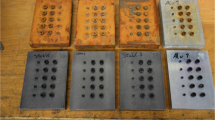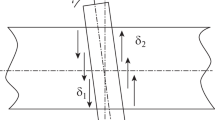Abstract—
Cylindrical keyed joint fits used in various assembly units of industrial machinery and agricultural machines have been considered. In most cases, these are clearance, less often, transitional fits due to the assembly and disassembly velocity criterion in this type of connection. In the clearance fits, wear occurs due to the initial relative surface movements, as well as abrasive and wear products occurring in the friction zone. The larger the clearance, the smaller the contact area, the higher the specific pressure, the greater the microshear velocity, the greater the number of contaminants in the contact zone, and the more intensive the surface wear. If there is clearance in the cylindrical fit, the key begins to move along the horizontal and vertical planes, thus leading to increased surface wear and crushing in the key connection with the shaft groove and the bushing groove. Given that the purpose of keyed joints in agricultural machinery is the transmission of large loads, it is recommended to use an interference fit of H7/s7, H8/х8, H8/u8, and H8/s8 to improve the durability substantially. The recommended interference fits have been compared in terms of the interference values in the sprocket shaft joint of the unified reducer H090.20, where 30H7/h9 was earlier used. Even with the highest interference fits, it is possible to dismantle the pressed cylindrical connection using manual pullers.


Similar content being viewed by others
REFERENCES
Erokhin, M.N., Leonov, O.A., Shkaruba, N.Zh., Amelin, S.S., and Bodunov, D.M., Application of dimensional analysis for calculating the total misalignment between a seal and a shaft, J. Mach. Manuf. Reliab., 2021, vol. 50, no. 6, pp. 524–529. https://doi.org/10.3103/S1052618821060066
Yao, H.X., Miao, E.M., and Niu, P.C., Selection of hole and axle interference fit tolerance, Appl. Mech. Mater., 2011, vols. 80–81, pp. 475–479. https://doi.org/ 10.4028/www.scientific.net/AMM.80-81.475
Li, Q., Yang, L., Zhao, W., Shi, Zh., and Liu, Zh., Design of positioning mechanism fit clearances based on on-orbit re-orientation accuracy, Appl. Sci., 2019, vol. 9, no. 21, p. 4712. https://doi.org/10.3390/app9214712
Repcic, N., Saric, I., and Muminovic, A., Software for calculation and analysis of ISO system of tolerances, deviations and fits, Ann. DAAAM Proc., 2012, vol. 23, no. 1, pp. 195–198.
Skvortsov, S., Khryukin, V., and Skvortsova, T., Statistical simulation and probability calculation of mechanical parts connection parameters for CAD/CAM systems, Advances in Automation. RusAutoCon 2019, Radionov, A. and Karandaev, A., Eds., Lecture Notes in Electrical Engineering, vol. 641, Cham: Springer, 2020, pp. 861–870. https://doi.org/10.1007/978-3-030-39225-3_93
Zou, Z.H. and Morse, E.P., A gap-based approach to capture fitting conditions for mechanical assembly, Comput.-Aided Des., 2004, vol. 36, no. 8, pp. 691–700. https://doi.org/10.1016/S0010-4485(03)00156-8
Boutoutaoua, H., Bouaziz, M., and Fontaine, J.F., Modeling of interference fits taking form defects of the surfaces in contact into account, Mater. Des., 2011, vol. 32, no. 7, pp. 3692–3701. https://doi.org/10.1016/j.matdes.2011.03.059
Leonov, O.A. and Shkaruba, N.Zh., A parametric failure model for the calculation of the fit tolerance of joints with clearance, J. Frict. Wear, 2019, vol. 40, no. 4, pp. 332–336. https://doi.org/10.3103/S1068366619040068
Leonov, O.A. and Shkaruba, N.Zh., Calculation of fit tolerance by the parametric joint failure model, J. Mach. Manuf. Reliab., 2020, vol. 49, no. 12, pp. 1027–1032. https://doi.org/10.3103/S1052618820120092
Zhang, Y. and Yang, M.S., A coordinate SPC model for assuring designated fit quality via quality-oriented statistical tolerancing, Comput. Ind. Eng., 2009, vol. 57, no. 1, pp. 73–79. https://doi.org/10.1016/j.cie.2008.12.006
Author information
Authors and Affiliations
Corresponding author
Ethics declarations
The authors declare that they have no conflicts of interest.
Additional information
Translated by E. Maslennikova
About this article
Cite this article
Leonov, O.A., Shkaruba, N.Z., Vergazova, Y.G. et al. Justification of Keyed Joint Fits. J. Mach. Manuf. Reliab. 51, 548–553 (2022). https://doi.org/10.3103/S1052618822060073
Received:
Revised:
Accepted:
Published:
Issue Date:
DOI: https://doi.org/10.3103/S1052618822060073




